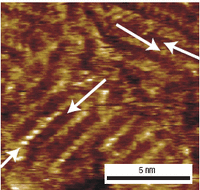Supramolecular approach to the development of SAMs
Researchers from the groups of Samori' and Lehn from ISOF-CNR in Bologna and the University Louis Pasteur in Strasbourg have described a method to design and obtain crystalline multicomponent SAMs without phase segegration and obtaining full miscibility of the two components. The investigated the use of two molecules, (Bis(4-pyridylcarboxamidododecyl)disulfide) and undecanethiol on Au(111) surfaces.
Thus they were able to achieve and control the pattern formation at the subnanometer scale of SAMs . These results will be of fundamental importance for recognition of target functional groups within other molecules and for the detection of single-molecule properties.
These research results have been obtained in the frame of the SONS Project SUPRAMATES.
Full details of this research can be found in G. Pace et al., Angew. Chem. Int. Ed., 2008, 47, 2484-2488.

Macrofibers formed by self-assembly
The joint activity between two nodes of the ESF-SONS2 project SUPRAMATES made it possible to exploit solvent-vapor annealing (SVA) to form millimeter-long crystalline perylene-bis(dicarboximide) (PDI) fibers on various solid substrates. Upon exposure to the vapors of a chosen solvent, the PDI needles prepared by spin-coating re-organize into long fibers that have a remarkably high aspect ratio, exceeding 103. Time- and space-resolved mapping with optical microscopy allows the self-assembly mechanism to be unravelled; the mechanism is found to be a nucleation-governed growth. SVA is found to lead to self-assembly featuring i) long-range order (up to the millimeter scale), ii) reversible characteristics, as proven through a series of assembly and dis-assembly steps, obtained by cycling different solvents, iii) remarkably high mass transport. Such a detailed understanding of the growth process is fundamental to control the formation of self-assembled architectures with pre-programmed structures and physical properties. The giant fibers can be grown in-situ in the gap between microscopic electrodes supported on SiOx, paving the way towards the application of SVA in micro- and nanoelectronics.
Full details of this research can be found in Giovanna De Luca, Andrea Liscio, Piera Maccagnani, Fabian Nolde, Vincenzo Palermo, Klaus Müllen, and Paolo Samorì, Advanced Functional Materials (selected by the editor as “Advances in Advance”)




